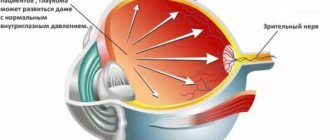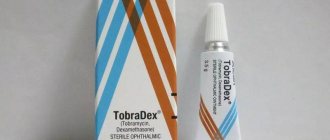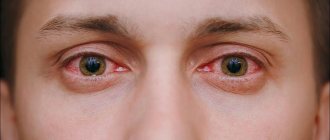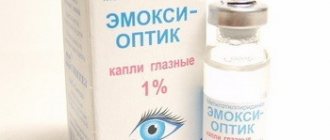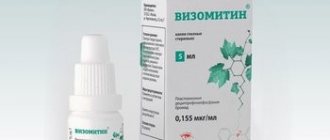Dexamethasone (drops) is a drug based on synthetic glucocorticosteroids. It is used for instillation into the eyes during exacerbation of viral or bacterial diseases, seasonal allergies. Hormonal components in a certain proportion enhance anti-inflammatory properties, relieve discomfort and swelling of the mucous membranes.
pharmachologic effect
Why is the drug prescribed? Dexamethasone is a glucocorticosteroid hormone that is used in ophthalmology as an antiallergic, anti-inflammatory, and antiexudative agent. The active component of the drug helps stabilize cell membranes and reduces the permeability of the vascular wall. The antiexudative (decongestant) effect is associated with the stabilization of the membrane membrane of lysosomes.
After instillation, dexamethasone can penetrate through the cornea into the fluid of the anterior chamber of the eyeball, even through intact epithelial cover. The drug has indications and contraindications
Release form and composition of the drug
The main active ingredient is dexamethasone sodium phosphate. It has pronounced anti-inflammatory properties, relieves tension and itching during acute manifestations of allergies. The component is a synthetic analogue of the hormone produced by the human adrenal glands. Its therapeutic effect is enhanced by the addition of:
- sodium tetraborate decahydrate;
- disodium edetate dihydrate;
- benzalkonium chloride;
- ethanol
Dexamethasone - complex drops into the nose or eyes, are a liquid translucent suspension.
Boric acid in the composition acts as a preservative and enhances the antibacterial effect of the drug. Normally, a small percentage of sediment or suspension is allowed. Dexamethasone drops are available in a 5 or 10 mm plastic bottle and have a dispenser. Thanks to its convenient form, it is not difficult for adult patients to carry out therapy at home: use does not require special skills. An additional cardboard box reliably protects from sunlight and contains instructions indicating the method of use.
Mode of application
To find out how much to drip the hormonal drug, read the instructions for use.
Children over 12 years old and adults:
- for chronic inflammatory changes, Dexamethasone should be instilled twice a day for a month;
- for acute inflammation, use 1-2 drops of the medicine, instill it 4-5 times a day only in the first two days, and after that 3-4 times for several more days;
- in case of injury or after surgery, the drug is instilled 2-4 times a day in a dose of 1-2 drops, the duration, depending on the intensity and severity of inflammation, is 2-4 weeks.
For children aged 6-12 years, the drug is prescribed for allergies and inflammation, 1 drop 2-3 times a day for 7-10 days. If longer use is required, it is necessary to first perform a fluorescein test to ensure the integrity of the corneal integumentary epithelium.
Before instillation, the bottle should be shaken so that the substance is evenly distributed in the solution.
Indications for use of the drug
The main indication for which Dexamethasone is prescribed is exacerbation of an allergic reaction in an adult patient. The drug expands and cleanses the tear ducts, normalizing fluid secretion. Helps stop burning and itching, relieves severe swelling of the mucous membranes. In combination with antihistamines, it improves a person’s condition when in contact with irritants.
Read more Instructions for using Parlazin drops, reviews and analogues
Common indications for use of the drug:
- scleritis;
- deep form of keratitis;
- blepharitis;
- uveitis;
- iridocyclitis;
- iritis
Indications for the use of eye drops Dexamethasone is a complication of conjunctivitis. The disease is characterized by a purulent course and profuse discharge, blurred vision and painful sensations. If not treated correctly, the disease becomes chronic. The use of hormones opens cell membranes, helping medicinal compounds penetrate inside. A similar problem is increasingly common after eyelash extensions by inexperienced specialists.
Eye drops 0.1% Dexamethasone relieve pain in case of corneal injury, after laser surgery to replace the lens or vision correction. Ophthalmologists can prescribe them for the complex treatment of infections that cause complications in the form of purulent inflammation.
Doctors do not prescribe drops as a preventative measure. The product can be used for severe burns after welding, combined with painkillers, analgesics, and saline solution for washing the eyes. Dexamethasone relieves tone in cases of optic neuritis and restores vision after cataract removal.
Contraindications
Dexamethasone is contraindicated for:
- with keratitis caused by the Varicella zoster and Herpes simplex viruses, as well as with viral damage to the conjunctiva and cornea;
- eye infection with mycobacteria;
- fungal infections of the eyeball;
- acute purulent pathologies of the eye;
- disruption of the structure of the corneal epithelium;
- increased intraocular pressure;
- the presence of individual sensitivity to drops.
Dexamethasone drops can be prescribed to women during pregnancy and feeding only in special cases when the possible benefit outweighs the threat and harm that can be caused to the fetus or newborn.
Contraindications for use
This is a synthetic hormone that penetrates hemolytic and placental barriers. Manufacturers have not conducted clinical trials in the treatment of pregnant women and young children, so doctors do not use drops for these categories of patients.
A contraindication to treatment with Dexamethasone is intolerance to any of the chemical components in the drops. This can intensify the manifestation of allergies and provoke Quincke's edema. They should not be used during exacerbation of the following diseases:
- fungal form of conjunctivitis;
- open wound of the cornea;
- herpes rashes on the mucous membrane of the eye;
- intraocular pressure;
- bleeding in the fundus;
- chickenpox, measles, rubella;
- severe mycobacterial infection.
Dexamethasone is not used for standard treatment of inflammation or irritation after lens wear. Before prescribing, it is recommended that a discharge test be performed to identify the underlying cause or type of bacteria.
special instructions
Due to a decrease in local immunity with long-term use of Dexamethasone, the development of a secondary fungal, viral or bacterial infection of the eye is possible.
Since intraocular hypertension may develop with prolonged use of the drug, intraocular pressure should be measured in case of treatment for more than 14 days.
Before instilling the solution into the subconjunctival sac, contact lenses should be removed. You can install them in their original place after a quarter of an hour.
If a secondary infection occurs during treatment, then additional antibacterial drops may be prescribed. If you are allergic, you should immediately stop using Dexamethasone drops.
Due to the fact that lacrimation may increase after instillation of the medicine, you should not use drops immediately before working with complex mechanisms or before driving a car.
Once opened, the bottle should be used within a month.
Pharmacological properties of the drug
Dexamethasone is an eye drop with a hormonal component that is used to treat lesions of the mucous membrane and cornea. When applied to the inflamed area, the active substance penetrates tissue cells and activates the production of amino acids and natural antibodies. This stimulates local immunity and helps relieve painful swelling and burning.
After instillation, it relieves acute inflammation, helps normalize metabolic processes and intraocular pressure. The main component expands the membranes of corneal and conjunctival cells, improving the penetration of other therapeutic drugs. The average period of action is 8–9 hours.
Analogs of Dexamethasone eye drops
There are several drugs that can act as substitutes for Dexamethasone drops. The most effective analogues:
- Xylene. It has vasoconstrictor properties and is used to eliminate allergy symptoms (lacrimation) before examining the fundus. For children, a concentration of 0.05–0.01% is recommended. The average price is 67 rubles.
- Tobrex. A combined remedy used to treat bacterial inflammation, relieves itching, burning, and aching pain. Contains the antibiotic tobramycin and the hormone dexamethasone. The price is 400–450 rubles.
- Maxitrol. The complex drops contain the antibiotic neomycin (Latin name Neomycin), dexamethasone and polymyxin. Effective for purulent infections, conjunctivitis, blepharitis. An adult patient can use it for staphylococcus, fungal infection of the cornea. The average cost is 540 rubles.
- Mezaton. Recommended before surgery or examination to dilate the pupil, used for iridocyclitis and asthenopia. Can be combined with Dexamethasone drops. The average price is 90 rubles.
- Ciprofloxacin. Refers to antibiotics that are effective against many types of bacteria and pathogenic microorganisms. It is not addictive and is well tolerated. To relieve the burning sensation, it is enough to instill it once a day. The average cost is 21 rubles.
Analogues of Dexamethasone eye drops are selected by the attending physician based on the diagnosis, symptoms and complaints of the patient.
Use of the drug during pregnancy and breastfeeding
Instructions for the use of drops, the affordable price of which attracts patients, excludes treatment with Dexamethasone during pregnancy. This is due to insufficient information about the effects on the embryo. In rare cases, it is allowed to instill it into the eyes of a pregnant woman after a corneal injury. The procedure is allowed in the last trimester and is carried out under the supervision of a doctor.
Read more Instructions for using Bimatan eye drops
The active component easily penetrates the thoracic ducts and is transmitted to the baby during feeding, so it is necessary to select a non-hormonal safe drug. Manufacturers allow the use of drops for 7–10 days if it is impossible to choose a high-quality analogue.
Side effects
If you strictly follow the dosage and recommendations for use, the risk of side effects is minimal. Possible complications include:
- deterioration of visual acuity;
- development of cataracts;
- swelling of the eyelid;
- ulcers and redness;
- increased intraocular pressure.
In rare cases, an allergy to the components in the composition (alcohol, synthetic hormone) occurs. Common side effects are burning, pain in the eyes, a “sandy” feeling, and excessive lacrimation.

